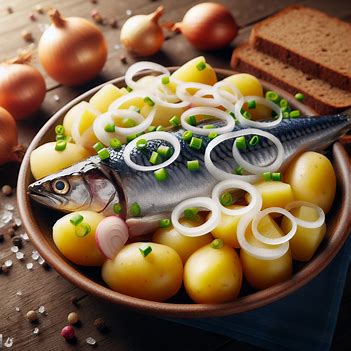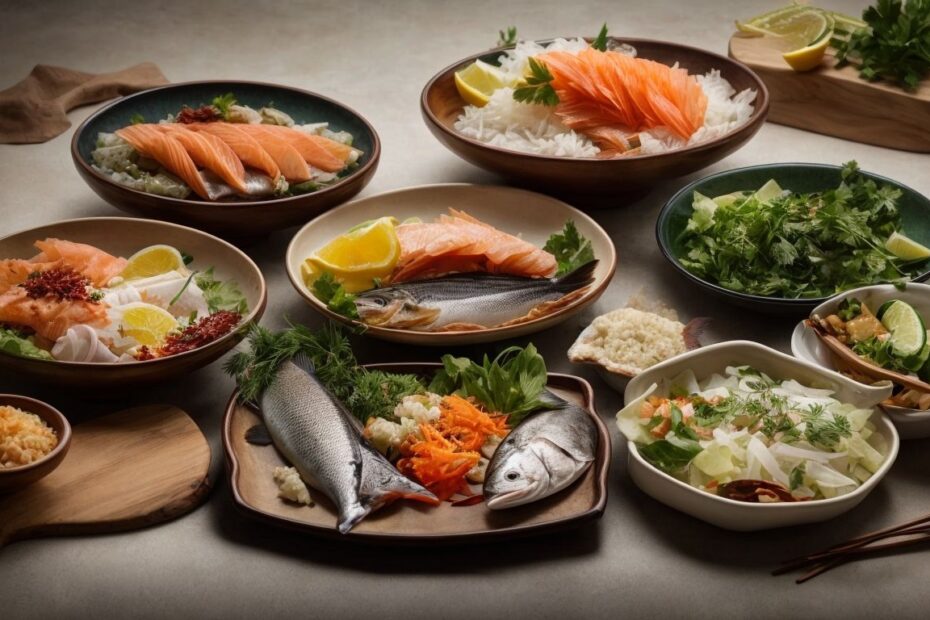Welcome to the world of fermented fish! If you’re someone who loves exploring new and unique food options, then this article is for you.
Fermented fish is a delicacy enjoyed in many cultures and has a wide range of health benefits. But which types of fermented fish are the most delicious? Read on to discover 8 mouth-watering examples that you don’t want to miss.
Introduction to fermented fish as a culinary tradition
Fermented fish is a culinary tradition in many cultures, known for its distinctive flavors and preservation properties. Some examples include Swedish surströmming, Korean hongeohoe, and Icelandic hákarl. The process of fermentation gives the fish a unique aroma and taste, making it an acquired delicacy.
Pro-tip: When trying fermented fish for the first time, it is recommended to pair it with strong, contrasting flavors to balance out the intense taste.
Exploring the cultural and historical significance of fermented fish
Exploring the cultural and historical significance of fermented fish reveals its integral role in various cuisines. From Southeast Asian shrimp paste to Swedish surströmming, fermented fish reflects centuries-old traditions and regional culinary identities. The preservation method was developed to ensure food availability in harsh climates or as a staple in local diets.
If you’re keen on exploring the world of fermented fish, consider trying Korean jeotgal, Filipino bagoong, or the Icelandic súr hkarl for unique flavor experiences!
Health benefits of consuming fermented fish
Consuming fermented fish can provide numerous health benefits, including:
- Rich in probiotics, which support gut health and aid in digestion.
- High in omega-3 fatty acids, which promote heart health and reduce inflammation.
- Packed with vitamin D, an essential nutrient for bone health and immune function.
- A good source of protein, which helps with muscle repair and growth.
Fun Fact: Fermented fish, such as Swedish surströmming, is notorious for its pungent odor. In fact, it is so strong that airlines have banned it due to its potential to explode at high altitudes!
Types of fish commonly used for fermentation
Types of fish commonly used for fermentation:
| Hongeohoe | Skate |
| Jeotgal | Salted and fermented fish |
| Pla ra | Fermented fish in Thailand |
| Surströmming | Fermented Baltic Sea herring |
The importance of fermented fish in various cultures and cuisines
Fermented fish holds a significant place in both cultural and culinary aspects around the world. In Korea, jeotgal, a type of salted fermented fish, is a crucial ingredient in many traditional dishes. Similarly, the Nordic countries have surströmming, a form of fermented herring, which is highly valued in their culinary heritage.
In Southeast Asia, fish sauce, a strong fermented condiment, is a popular ingredient in cooking. For centuries, fermented fish has played a crucial role in preserving food, especially in regions with limited access to fresh fish.
Top 8 delicious fermented fish examples from around the world

- Surströmming: A Swedish fermented herring known for its pungent smell and acquired taste.
- Hongeohoe: Korean skate that’s been fermented for several weeks, boasting a strong ammonia-like odor.
- Pla Ra: Thai fermented fish with a pungent aroma, commonly used in various Thai dishes.
- Fesikh: An Egyptian fermented mullet, traditionally eaten during the Sham El-Nessim festival.
- Garum: Ancient Rome’s fermented fish sauce, popular for enhancing the flavor of dishes.
- Prahok: Cambodian fish paste, a staple ingredient in Cambodian cuisine.
- Hákarl: An Icelandic fermented shark, featuring a strong ammonia scent and intense flavor.
- Kusaya: Japanese salted-dried fermented fish that’s famous for its strong smell and taste.
Are you ready to explore these unique fermented fish delicacies? Bon appétit!
Traditional recipes using fermented fish
Here’s a table showcasing traditional recipes using fermented fish:
| Recipe | Origin | Main Ingredients |
| Kimchi | Korea | Fermented fish, Napa cabbage, Korean radish |
| Pla Ra | Thailand | Fermented fish, salt, roasted rice, garlic |
| Prahok | Cambodia | Fermented fish, prahok tree bark, sticky rice |
In a remote village, a family passed down their secret fermented fish recipe for generations, bringing the community together for a yearly feast.
Modern twists on traditional fermented fish dishes

Modern twists on traditional fermented fish dishes offer innovative flavors and textures while preserving cultural heritage.
- Kimchi-infused pickled herring
- Wasabi-spiced fermented mackerel
- Thai-style fermented fish tacos
- Scandinavian gravlax with a twist of citrus
Tips for incorporating fermented fish into your diet
- Start with small amounts to acquire the taste gradually.
- Experiment with different types of fermented fish, such as Swedish surströmming or Korean hongeohoe, to find your preferred flavor profile.
- Explore various recipes from different cuisines, like Thai pla raa or Filipino burong isda, to diversify your meals.
Pairing suggestions for fermented fish dishes
Pair fermented fish dishes with complementary flavors for a delightful dining experience.
Acidic Fruits: Pair with citrus fruits like lime or lemon to balance the rich, pungent flavors.
Herbs and Greens: Serve with fresh herbs like dill, parsley, or cilantro to add a burst of freshness.
Heat: Consider adding a spicy element like chili peppers or hot sauce for a kick of heat.
Common misconceptions about fermented fish
Common misconceptions about fermented fish:
- Overpowering smell: Fermented fish has a strong aroma, but with proper preparation and cooking, the intensity can be reduced.
- Unsafe to eat: When prepared and stored correctly, fermented fish is safe to consume, just like the Swedish delicacy surströmming.
- Unappealing taste: While it does have a distinct flavor, fermented fish can be delicious when used in traditional dishes such as Korean kimchi stew.
Pro-tip: To ease into fermented fish, start with milder variations like Thai pla ra before exploring stronger flavors.
Alternative options for vegetarians and vegans
For vegetarians and vegans, there are various alternative options to fermented fish. These include fermented tofu, tempeh, miso, natto, kimchi, sauerkraut, kombucha, and fermented vegetables like pickles and olives.
The concept of vegetarianism has been around for centuries, with evidence of vegetarian diets dating back to ancient Indian and Greek civilizations.
Fermented fish as a sustainable food source

Utilizing fermented fish as a sustainable food source offers numerous benefits, such as reducing food waste and providing a nutrient-rich option. Examples like Swedish surströmming and Korean hongeohoe showcase cultural diversity and culinary innovation.
Additionally, fermented fish aligns with eco-conscious practices by repurposing excess catch. Including fermented fish in your diet contributes to sustainable food consumption and supports traditional food preservation methods.
Consider exploring unique fermented fish dishes like Vietnamese mam ca loc and Icelandic hakarl to expand your culinary repertoire while embracing sustainable food choices.
DIY guide for fermenting your own fish at home
- Prepare the fish by cleaning and cutting it into the desired pieces.
- Create a brine solution by mixing salt and water in the correct proportions.
- Submerge the fish in the brine solution and let it ferment for the required duration at a specific temperature.
- Monitor the fermentation process, ensuring that the fish is properly submerged and the brine remains uncontaminated.
- After fermentation, remove the fish from the brine, rinse it, and let it air-dry.
- Store the fermented fish in a cool, dark place, allowing it to mature to the desired taste.
Conclusion: Why fermented fish is a must-try for food enthusiasts
Fermented fish is a culinary adventure that every food enthusiast should embark on. The rich, intense flavors and unique textures of fermented fish dishes offer a sensory experience like no other. For those seeking to expand their culinary horizons, exploring fermented fish opens up a world of delectable possibilities.
From the pungent delicacy of Swedish surströmming to the umami-packed Korean hongeohoe, fermented fish is a must-try for adventurous food lovers.
Frequently Asked Questions
What are some examples of delicious fermented fish?
Some examples of delicious fermented fish include kimchi, pickled herring, narezushi, surströmming, pla ra, balao-balao, bagoong, and shiokara.
What is kimchi?
Kimchi is a traditional Korean dish made from fermented vegetables, often including fish, spices, and seasonings. It is a staple in Korean cuisine and is known for its tangy, spicy, and slightly sour flavor.
Is pickled herring a type of fermented fish?
Yes, pickled herring is a type of fermented fish. It is typically marinated in a brine solution of vinegar, salt, and sugar, which helps to preserve the fish and create its distinct flavor.
What is narezushi?
Narezushi is a type of fermented fish dish that originated in Japan. It is made by fermenting fish, typically mackerel, for several months in rice vinegar and salt. The result is a strong, pungent flavor that is often served as a condiment or side dish.
What is surströmming?
Surströmming is a traditional Swedish dish made from fermented Baltic herring. The fish is fermented in barrels for several months, creating an extremely pungent and strong-smelling dish that is often served with potatoes and onions.
What is bagoong?
Bagoong is a Filipino condiment made from fermented fish or shrimp. It is commonly used as a flavoring in many dishes, including stews, soups, and sauces, and is known for its strong, salty taste.

